Trivago Bundle
How is Trivago Redefining Travel Search in 2025?
Trivago's recent strategic overhaul, particularly in its sales and marketing, is generating significant buzz. Witnessing a resurgence in revenue, the hotel booking platform is leveraging brand marketing and AI integration to capture market share. This shift marks a pivotal moment for the travel metasearch engine, promising exciting developments for both consumers and investors.
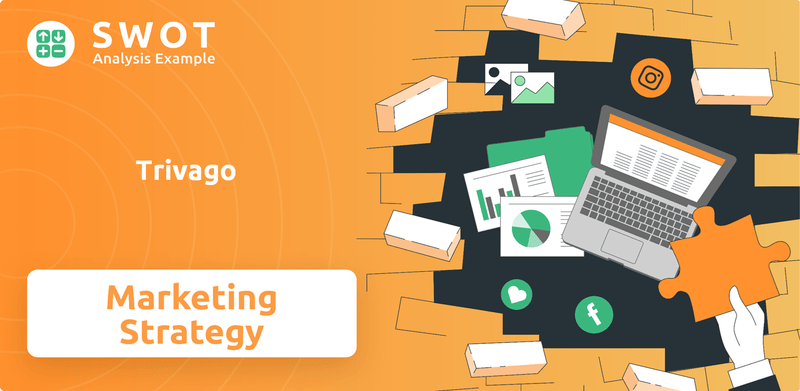
From its roots as a simple hotel search engine, Trivago's Trivago SWOT Analysis reveals a fascinating evolution of its Trivago sales strategy and Trivago marketing strategy. The company's success now hinges on a data-driven approach, including its innovative Trivago business model, to navigate the competitive online travel agency landscape. This document will explore the intricacies of Trivago's advertising campaigns analysis, its customer acquisition strategies, and how it has strategically positioned itself as a leading global hotel search platform, offering valuable insights for understanding its growth trajectory.
How Does Trivago Reach Its Customers?
The core of the Trivago sales strategy revolves around its online platform, functioning as a global hotel and accommodation search engine. This platform is accessible through its website and mobile applications, available in 53 localized versions and 31 languages. Trivago acts as a travel metasearch engine, aggregating data from various sources, including online travel agencies (OTAs) and hotels, rather than directly selling hotel rooms.
Trivago's marketing strategy has evolved, with a shift towards branded channel traffic. This includes direct traffic to its platforms through localized websites, mobile apps, and branded search engine optimization (SEO). This strategic move aims to diversify marketing efforts and reduce reliance on platforms like Google, while also converting offline travelers to the online realm.
In the first quarter of 2025, Trivago reported strong growth in referral revenues across all segments. The Rest of World segment saw a 44% increase, Developed Europe grew by 19%, and the Americas segment experienced an 18% rise. This growth was primarily driven by increased branded channel traffic, supported by ongoing brand marketing investments. This data highlights the effectiveness of Trivago's sales and marketing strategy in driving revenue through its platform.
Trivago's primary sales channels include its website and mobile applications, which are available globally. These platforms are localized across 53 websites and apps in 31 languages. The company uses a metasearch model, directing users to various booking sites and hotels.
A significant shift in Trivago's marketing strategy involves focusing on branded channel traffic. This includes direct traffic to its platforms through localized websites, mobile apps, and branded SEO. The goal is to diversify marketing efforts and attract offline travelers online.
Partnerships play a crucial role in Trivago's revenue generation. Expedia Group brands contributed 35% of referral revenue in Q1 2025, while Booking Holdings brands accounted for 40%. This highlights the importance of strategic alliances in the company's business model.
Trivago's investment in Holisto, an AI-driven tech platform, aims to enhance conversion rates. This partnership offers more consistent booking experiences and provides partners with additional visibility among price-conscious members, improving the user experience.
Trivago's success is significantly influenced by its strategic partnerships and the shift towards branded channels. These efforts have driven substantial revenue growth, as seen in the Q1 2025 results.
- Expedia Group brands accounted for 35% of referral revenue.
- Booking Holdings brands contributed 40% to referral revenue.
- The focus on branded channels has increased direct traffic and brand recognition.
- Investment in AI-driven platforms like Holisto aims to improve user experience.
Trivago SWOT Analysis
- Complete SWOT Breakdown
- Fully Customizable
- Editable in Excel & Word
- Professional Formatting
- Investor-Ready Format
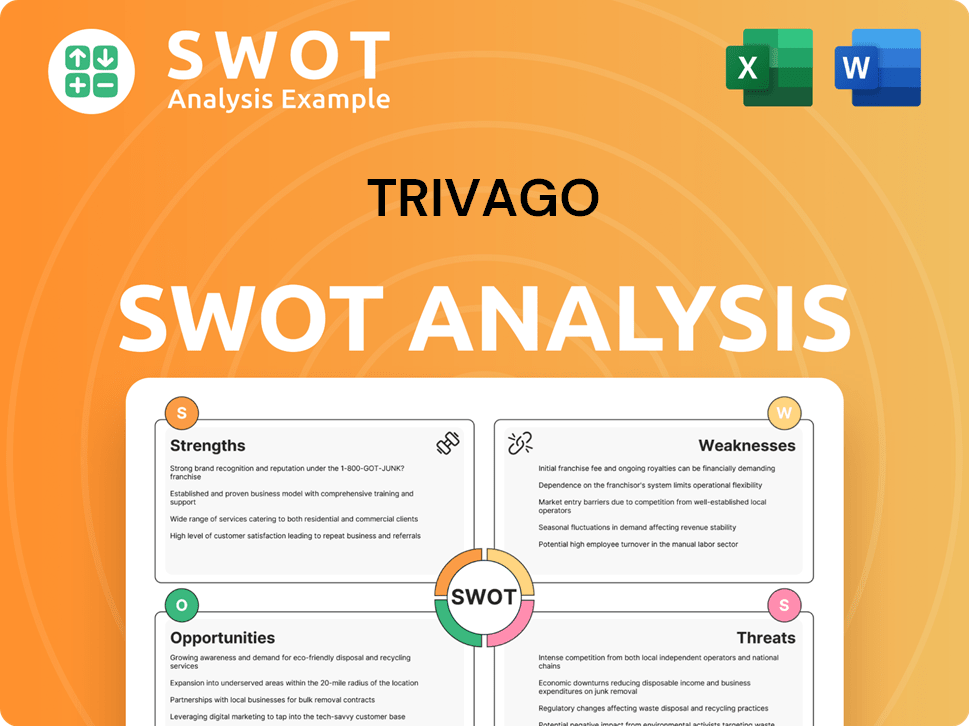
What Marketing Tactics Does Trivago Use?
The company's marketing tactics are heavily focused on data-driven advertising and enhancing user experience. This approach utilizes digital channels extensively, alongside traditional media, to build brand recognition and drive conversions. The company leverages advanced analytics to target specific user segments, optimizing marketing spend and improving customer acquisition strategies.
Digital marketing plays a central role in the company's strategy, employing various tactics such as content marketing, SEO, paid advertising, and social media engagement. These efforts are complemented by traditional media, particularly TV advertising, to reach a broad audience. The company's Return on Advertising Spend (ROAS) was stable at 118.1% in Q1 2025, demonstrating efficient advertising despite increased brand marketing investments.
The company's marketing strategy is designed to drive traffic and bookings through a combination of digital and traditional methods. This includes continuous experimentation to improve user experience and conversion rates. For more insights, you can explore the Target Market of Trivago.
The company uses content marketing, SEO, and paid advertising (like Google Ads) to attract users. Email marketing, influencer partnerships, and social media are also key. They use data to target specific user segments, ensuring marketing efforts align with customer needs.
TV advertising is a significant part of the marketing mix, aimed at building brand recognition. In Q4 2024, increased brand marketing investments, especially in Developed Europe and the Americas, contributed to revenue growth. Total advertising spend increased by €20.4 million, or 24%, in Q1 2025 compared to Q1 2024.
The company uses data to segment customers and personalize their experience. They constantly run experiments to improve user experience and conversion rates. Innovations include AI-powered TV ads and new personalization algorithms for search results.
The company utilizes AI algorithms through technology like RTB House to tailor ads in real-time. This helps in achieving higher conversion rates and lower acquisition costs. They also use AI for features like Smart Search and AI Highlights for hotels.
The company focuses on improving user experience and conversion rates on its core hotel search product. They are developing a differentiated member proposition for price-savvy travelers. Exclusive deals are also extended to signed-on members.
Total advertising spend increased in Q1 2025. The company's ROAS was stable at 118.1% in Q1 2025, compared to 119.2% in Q1 2024. This indicates efficient advertising despite increased brand marketing investments.
The company's marketing strategy combines digital and traditional methods, emphasizing data-driven insights and user experience. This approach aims to attract and retain customers effectively.
- Data Analytics: Using data to target specific user segments and personalize marketing efforts.
- Content Marketing: Creating valuable content to attract and engage potential customers.
- SEO: Optimizing content to improve search engine rankings.
- Paid Advertising: Utilizing platforms like Google Ads to drive traffic and conversions.
- Brand Building: Investing in TV advertising to increase brand recognition.
- Customer Segmentation: Dividing the customer base into groups to tailor marketing messages.
- AI Integration: Implementing AI-powered tools for ad personalization and search results.
Trivago PESTLE Analysis
- Covers All 6 PESTLE Categories
- No Research Needed – Save Hours of Work
- Built by Experts, Trusted by Consultants
- Instant Download, Ready to Use
- 100% Editable, Fully Customizable
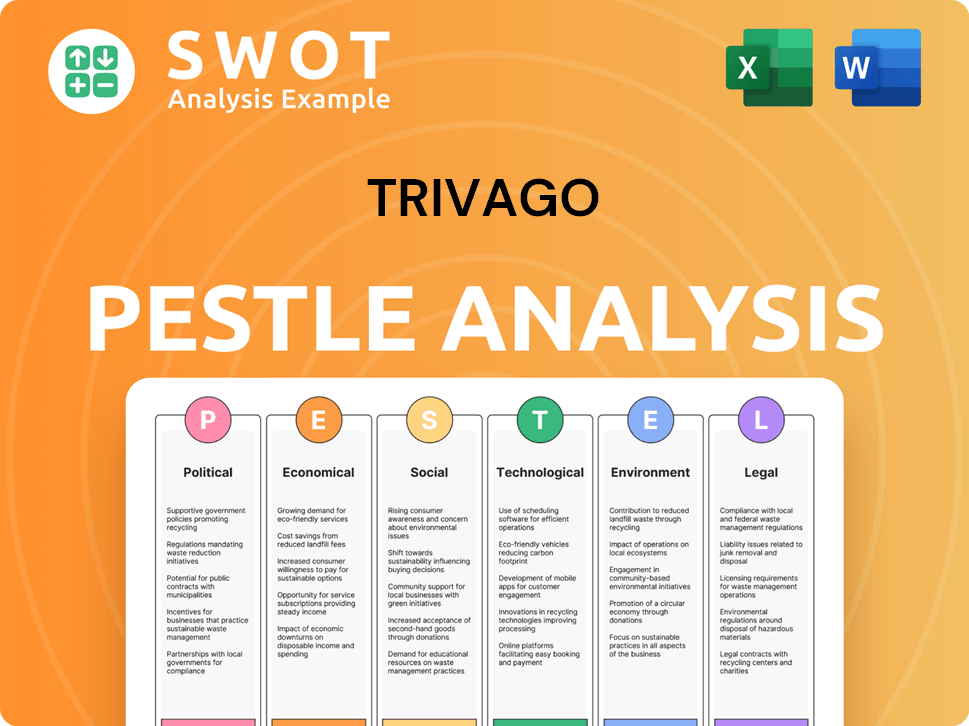
How Is Trivago Positioned in the Market?
The brand positioning of the company is centered on its identity as a global hotel search platform. It empowers travelers to find the best deals by comparing prices from various booking sites and hotels worldwide. The core message highlights user convenience and the provision of comprehensive information, enabling informed decision-making for consumers.
The visual identity and tone of voice are typically straightforward and consumer-friendly, emphasizing simplicity and efficiency in the hotel search process. The company differentiates itself by acting as a comprehensive metasearch engine, which is a unique selling proposition that appeals to price-conscious consumers seeking value and transparency. This approach helps the company stand out in the competitive online travel agency (OTA) market.
The company's focus is on value and a seamless user experience, which is how it appeals to its target audience. The platform is optimized for better search and comparison functionalities, which fosters engagement and contributes to customer retention. A key aspect of its appeal is the emphasis on 'price-savvy shoppers' who compare prices to ensure they get a great deal. To understand the competitive environment, a deeper dive into the Competitors Landscape of Trivago can provide valuable insights.
The core value proposition of the company is to empower travelers to find the best hotel deals by comparing prices from numerous booking sites. This metasearch approach allows users to access a broad range of options and make informed decisions. The platform's focus is on providing value and a seamless user experience.
The company's target audience includes price-conscious travelers seeking value and transparency in their hotel bookings. These are individuals who prioritize finding the best deals and are willing to compare prices across different platforms. The platform's user-friendly interface and comprehensive search capabilities cater to this demographic.
The company differentiates itself by acting as a metasearch engine, which is a unique selling proposition. Unlike traditional online travel agencies, it does not sell hotel rooms directly. This allows it to focus on providing a comprehensive comparison of prices and options, appealing to users looking for the best deals.
The company maintains brand consistency across its 53 localized websites and apps in 31 languages. This ensures a familiar user interface and a consistent user experience globally. This consistent approach helps build brand recognition and trust among international users.
Trivago Business Model Canvas
- Complete 9-Block Business Model Canvas
- Effortlessly Communicate Your Business Strategy
- Investor-Ready BMC Format
- 100% Editable and Customizable
- Clear and Structured Layout
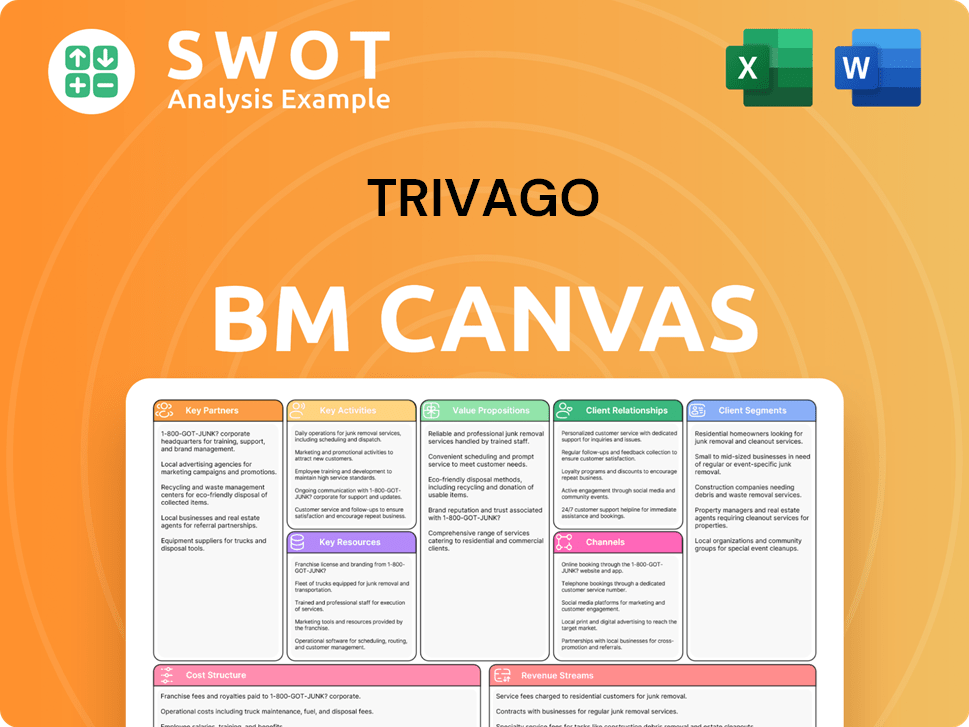
What Are Trivago’s Most Notable Campaigns?
The company's sales and marketing strategy has recently centered on high-profile campaigns designed to boost brand awareness and drive direct traffic. A key element of this strategy involves the use of AI-powered campaigns, which have been rolled out in major markets like the United States, the United Kingdom, and Canada. These initiatives aim to shift the focus away from performance marketing and towards building a stronger brand presence.
One of the most significant recent campaigns features Brand Ambassador Jürgen Klopp, launched in late December 2024. This move reflects a strategic shift towards brand-focused investments, which the company believes are crucial for long-term growth. The early results from these campaigns have been promising, signaling a positive trajectory for the company's brand revenue.
Historically, the company has relied heavily on TV advertising to build brand recognition and communicate its value proposition of hotel price comparison. The company's commitment to brand building is evident in its long-standing investment strategy, which has involved billions of dollars spent across more than 50 countries since 2009. This approach aims to diversify marketing efforts and transition travelers from offline to online platforms.
The Jürgen Klopp campaign, launched in late December 2024, is a pivotal element of the company's marketing strategy. This campaign leverages AI-powered tools and targets key markets such as the United States, United Kingdom, and Canada.
The company has a history of using frequent TV ads to build brand recognition. These ads have been instrumental in reaching a wide audience and communicating the value proposition of hotel price comparison. The 'Where Would You Be Without' campaign is a prime example.
Since 2009, the company has invested billions in brand building across more than 50 countries. This strategy aims to diversify marketing efforts and transition travelers from offline to online platforms. This demonstrates a long-term commitment to brand development.
In Q4 2024, revenue from branded channel traffic increased year-over-year in the Americas and Rest of World segments. The investment in brand marketing has led to sequential improvements in Developed Europe. The company observed strong double-digit revenue growth in January 2025.
The success of these brand-focused campaigns is evident in the shift in referral revenue dynamics. In Q4 2024, revenue from branded channel traffic grew year-over-year in the Americas and Rest of World segments, and showed sequential improvement in Developed Europe, driven by brand marketing investments. While total advertising spend increased by €0.2 million in Q4 2024 compared to the same period in 2023, primarily due to higher brand marketing investments, the overall advertising spend for the full year 2024 increased by 7% to €345.4 million. This strategic shift, including campaigns with a prominent figure like Jürgen Klopp, aims to drive sustainable growth and enhance the company's competitive position by attracting more direct traffic and improving conversion rates. For a deeper understanding of the company's trajectory, consider reading a brief history of the company.
Trivago Porter's Five Forces Analysis
- Covers All 5 Competitive Forces in Detail
- Structured for Consultants, Students, and Founders
- 100% Editable in Microsoft Word & Excel
- Instant Digital Download – Use Immediately
- Compatible with Mac & PC – Fully Unlocked
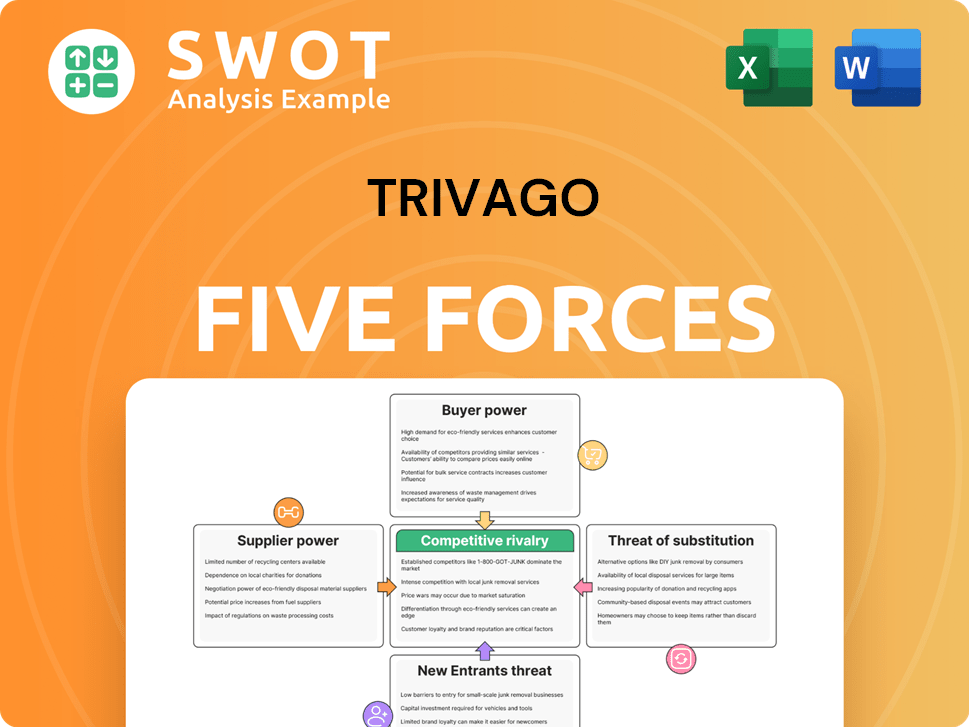
Related Blogs
- What are Mission Vision & Core Values of Trivago Company?
- What is Competitive Landscape of Trivago Company?
- What is Growth Strategy and Future Prospects of Trivago Company?
- How Does Trivago Company Work?
- What is Brief History of Trivago Company?
- Who Owns Trivago Company?
- What is Customer Demographics and Target Market of Trivago Company?
Disclaimer
All information, articles, and product details provided on this website are for general informational and educational purposes only. We do not claim any ownership over, nor do we intend to infringe upon, any trademarks, copyrights, logos, brand names, or other intellectual property mentioned or depicted on this site. Such intellectual property remains the property of its respective owners, and any references here are made solely for identification or informational purposes, without implying any affiliation, endorsement, or partnership.
We make no representations or warranties, express or implied, regarding the accuracy, completeness, or suitability of any content or products presented. Nothing on this website should be construed as legal, tax, investment, financial, medical, or other professional advice. In addition, no part of this site—including articles or product references—constitutes a solicitation, recommendation, endorsement, advertisement, or offer to buy or sell any securities, franchises, or other financial instruments, particularly in jurisdictions where such activity would be unlawful.
All content is of a general nature and may not address the specific circumstances of any individual or entity. It is not a substitute for professional advice or services. Any actions you take based on the information provided here are strictly at your own risk. You accept full responsibility for any decisions or outcomes arising from your use of this website and agree to release us from any liability in connection with your use of, or reliance upon, the content or products found herein.